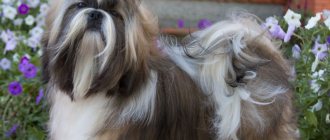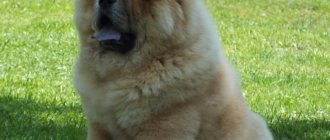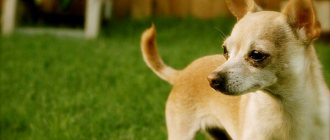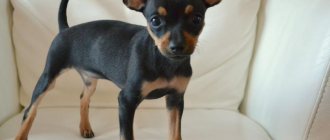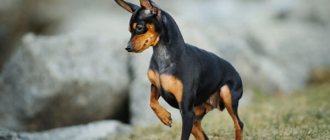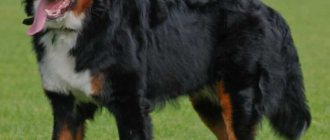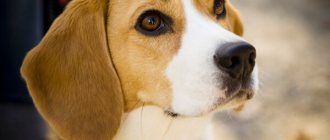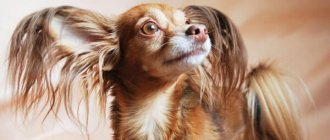Historical reference
The Czech Terrier dog is a rarity and, one might say, a novelty . The history of development is known almost step by step, but it does not shine with particularly interesting facts. So, one dog trainer wanted to get a new breed...and that's how it all began. It is interesting that the parent of the Czech Terriers was breeding similar dogs, but apparently was not too happy with them.
Scottish Terriers are a breed line that the breeder decided to improve. According to the dog handler, the dogs were too wide and bulky to work on small animals... and not too hardy to hunt medium-sized ones. If you look at the history of the Scottish Terrier breed, it is difficult to draw a conclusion about their successful use, and the breeders did not have any particular complaints. Perhaps there is smaller game in the Czech Republic or the reason for this is the eccentricity of the parent of the Czech Terriers, but the decision to breed the breed was made almost instantly. By the way, Czech terriers really have an advantage over their Scottish counterparts - a calmer character.
The new breed was based on Sealyham Terriers and Scotch Terriers. The work turned out to be more difficult than it seemed. The process of breeding Czech Terriers took more than 10 years. During this long period, the breeder more than once resorted to inbreeding with other breeds, including Dandy Dynemont Terriers. It is interesting that the initial requirements for the new breed were very few:
- Calm disposition and anger towards the beast.
- Stretched format.
- Small height so that the dog can freely enter the hole.
- Dark wool.
It is not surprising that the appearance of Czech Terriers is so similar to their ancestors, because all of them almost completely meet the final requirements. The representative name - Bohemian Terrier , was assigned to the breed after the first exhibition in 1959. The events took place in the Bohemian Theater, and the dogs amazed the judges, as they acted as the new and the well-forgotten old.
This is interesting! Despite the first success, official recognition of the breed occurred only in 1963. According to the rules of the FCI (Federation Cynologique Internationale), the name of the breed must indicate its origin in the place where it was bred. Bohemian Terrier is a widespread, beautiful or embellished name, and Czech Terrier is the official name specified in the standard.
Breeding work to breed and increase the breed's population continues to this day. It is encouraging that American kennel clubs, whose breeding control is much higher, have become involved in the work. The future of the Czech Terrier is unclear, since even with the existing, officially recognized population, breeders are forced to resort to interbreed matings to dilute the blood. Most often, Sealyham Terriers are used in breeding work, and the born puppies, if they meet the standard of the first breeding inspection, receive Czech Terrier documents.
A little history
The Czech Terrier is considered a young artificially bred dog breed. The breed was bred by Frantisek Horak. The idea to breed a new terrier came from a Czech cynologist who breeds Scottish terriers. Frantisek Horak noted the wide chest of the breed, which often made it difficult for the miniature animal to crawl into the hole. The breeder begins to breed a new breed with a narrow chest and, in addition, a calm character. Scotch terriers and Selham terriers were selected for breeding. Later, the blood of a dandy dinmont terrier came in.
After a painstaking 10-year selection work, the world saw a new terrier with fantastic working qualities and a relatively good-natured character. The breeder's goals were based on the following conditions: it was necessary to obtain an elongated dog that could freely climb into a hole, preferably of a dark color.
As a result of the selection work, we got a funny short-legged dog with a slightly elongated format, energetic and tireless on the hunt. The Czech Terrier reflected the main features of both parents - externally and in character.
The breeder began work in 1949, and already in 1959 he presented the first Bohemian Terrier at an exhibition. The new breed displays the features of both ancestors, and at the same time has a graceful build and softer coat. The new breed is distinguished by a calm temperament. The Czech Terrier dog breed officially appeared in 1963. The name was chosen to indicate the place of birth of the dog.
A little later, the dogs find their way to America. Today the number of individuals is small. Trying to increase the number of animals, they often lose the characteristics of the breed; Selichem blood infusions are carried out periodically.
Appearance
The official description of the breed presents the Czech Terrier as a comfortable dog in every sense. These unusual, short-legged dogs are successfully trained to work, and their physique is only a plus for hunting in a hole. Short legs do not in any way affect the physical strength and anger of the Czech Terrier, therefore, if necessary, he is trained to work on the ground (badger, fox).
Visually, females are a little more refined and elongated than males, but this difference does not affect physical strength and strength. Males are distinguishable by their muzzle and look. The dimensions of dogs vary within the same limits regardless of gender:
- Height: 27–30 cm.
- Weight: 6–9 kg.
Convenience in the compactness and versatility of the breed. According to the standard, the Czech Terrier is a small pet, agile, active, persistent, but not wasting energy. Despite the stockiness, the body composition is very harmonious and proportional, with the exception of height.
Breed standard
- The head is rectangular, the muzzle is wedge-shaped, the silhouette is emphasized by a beard and eyebrows, the back of the head is convex. The forehead is not wide, almost flat, slightly tapering. The transition is marked and separated by a groove. The bridge of the nose is elongated and smooth. The brow ridges are not clearly expressed, but are emphasized by the coat. The cheekbones are developed and fit harmoniously into the silhouette. Both jaws are fully developed, moderately wide and strong. The lips are not dry, but elastic and not saggy.
- The teeth are large, in the correct bite, the incisors are in line.
- Nose – black, brown or light brown, proportional.
- The eyes are small, blue set, well covered with eyebrows. The look is measured, not defiant, attentive. The color of the irises ranges from rich brown to light hazel depending on the coat color. The eyelids are tight-fitting, dry, colored to match the nose.
- The ears are triangular, medium-sized, set high, lowered to the head. Movable on cartilage, refracted in the first third. The rounded tips of the ears are adjacent to the cheekbones, the auricle is completely covered.
- The body is strongly built and squat. The neck is of proportional length, wide, oval, set harmoniously at an angle of 45°, the scruff is not pronounced, there are no folds, although the skin is not dry. The body is not too long, proportional, the back is straight and wide, the withers are powerful. The chest is oval, well elongated, voluminous, descending to the elbows or slightly below. The ribs are rounded, easily palpable, extended towards the groins. The loin is very muscular, the croup is very strong, neat, sloping. The belly is not dry and should not interfere with rapid movements.
- Limbs – Unlike most short-legged dogs, the Czech Terrier's limbs should be straight. When moving, the dog quickly throws out its paws, and the amplitude should not be sweeping. The front legs are straight, the bones are large, visually, the legs look powerful. The shoulder blades are pressed to the body, but are free to move, the shoulders are well muscled, the elbows do not rub against the body, they are directed strictly back, not tucked in, not turned out. The hind legs are set wider than the front legs and pulled back, the bones are powerful. The thighs are muscular, not too long. The shins are elongated, set at a harmonious angle. Due to the shortened shins, the hock joints are slightly elevated, directed only back. The hands of the front paws are larger than those of the hind paws. The paw pads are large and convex. The claws are strong, curved, pigmentation is not important, but should be in harmony with the color.
- The tail is thick and long in comparison with the body. Set on almost in line with the back or slightly higher. Carries freely, in a state of excitement - above the line of the back, slightly curved.
Disadvantages of the breed
Czech Terriers are not considered a common dog breed. For the breeder this sometimes causes inconvenience.
Czech terriers are distinguished by excellent health, but from their Scottish ancestors they inherited a disease - Scotty Crump syndrome. The meaning of the disease lies in the convulsive state into which the dog falls. Periodic manifestations of seizures affect the terrier's coordination, but are not considered a fatal disease. The contractions quickly pass, and the dog continues to behave in its usual way. However, for the owner, each attack becomes an additional dose of stress.
The “eternally hungry” Czech terrier steals food everywhere, from the table in the owners’ kitchen, in trash cans. It is necessary to raise the dog so that the dog does not allow himself such antics.
Tips for choosing a puppy
We are talking about a very rare, small breed, so finding Czech Terrier puppies is not so easy. Nurseries that have proven themselves to be good are located in America and the Czech Republic. Puppies are booked in advance and assessed after birth. According to generally accepted practice, the algorithm of actions is as follows:
- Contact the nursery - all organizations have websites, although most of them are in English.
- Express your wishes – gender and class (show, breed, pet) of the puppy.
- Discuss upcoming litters for which reservations are still open.
- Wait and save money, since a puppy cannot cost less than $500-600, and besides the dog, you need to purchase many accessories, pay for veterinarian services, etc.
Price, waiting periods and (most importantly) the conditions under which puppies are sold are individual factors that depend only on the owners of the kennel. The higher the prospects of the litter, the more likely it is that the puppies will be sold under a co-ownership agreement. Simply put, you will need to fulfill the conditions and only then the dog will become completely yours. Most often we are talking about one litter of puppies to continue the bloodline.
Important! Never buy rare dogs secondhand, and especially without a full package of documents! If you don’t have experience, get advice. If you “fall for” fairy tales from dishonest sellers, this is only your responsibility.
Nutrition
Czech Terriers are big eaters. They are not at all picky about food, and are ready to eat anything that comes their way. But you should not follow the animal’s lead and feed it large portions at any time of the day. The diet must be strictly followed. An adult terrier should be fed twice a day, after a walk, so that the dog has the opportunity to lie down and rest after eating. There should be no snacks between meals. Never train your dog to be near you when you eat. Remember that food must be of high quality, fresh and healthy. Dogs should not be given sweets or yeast baked goods, even occasionally as rewards. Treats should be chosen in specialized stores. In addition, dogs should not eat fatty, canned or pickled foods; dishes that contain spices, as well as all kinds of sausages. A dog's diet should include meat, fish, cottage cheese, eggs, cereals (buckwheat and rice), fruits, vegetables and herbs. In addition to these products, you can give your dog additional vitamin complexes. However, first consult with your veterinarian about which vitamins are needed for the full development of your pet.
Maintenance and care
Czech Terriers are energetic and tireless, so regardless of the type of home they need active walking. When living in a house with an adjacent plot, the owner should take into account that dogs are excellent and fast diggers... that is, they can dig a hole and escape.
Caring for the Czech Terrier will not be particularly difficult even for working owners, although it does include several mandatory rituals. Grooming is mandatory for show dogs and is important for owners who want to maintain the spectacular appearance of their pet. In rainy weather, it is better to protect the coat with a raincoat rather than wash it after every walk.
The wool is combed several times a week. During shedding, the dog needs to be scratched every day. Bathing is carried out as needed, preferably no more than 2 times a year. The ears adjacent to the head should be inspected and cleaned regularly. Czech Terriers rarely have problems with their eyes. With proper bite, dogs' teeth remain healthy into old age. The claws need to be cut, and the puppy must be accustomed to the procedure from 6–7 months of age.
Description
The Czech Terrier is a small dog of moderately elongated size. He may appear stocky, but he is rather muscular and robust.
At the withers, dogs reach 25-32 cm and weigh 7-10 kg. A distinctive characteristic is the coat: soft, long, fine, silky, slightly wavy in texture. On its muzzle it forms a mustache and beard, and thick eyebrows on its eyes.
The coat color is mostly gray with black pigmentation. A rarer color: coffee brown with black pigmentation on the head, beard, cheeks, ears, paws and tail. White and yellow spots on the head, neck, chest, and paws are acceptable. Puppies are born black, but gradually the coat changes color.
Feeding
A balanced diet for a dog is an important component of good health, proper metabolism and energy of the pet. The owner needs to make a key choice of the type of food - natural or industrial, then everything will depend on the individual characteristics of the pet.
Good quality industrial feed contains all the necessary substances, vitamins and microelements for the full growth and development of the animal. Products are selected strictly according to the physiological needs, age and weight of the dog. Secondary selection criteria are coat type and temperament. You shouldn’t even think about inexpensive food, because this method of feeding is more convenient for the owner, but it is harmful for the dog! Expensive and high-quality food is not always accepted equally well by dogs, so you should not buy new food for future use.
Training, training
Czech Terriers are easy to train. They always try to earn the owner's approval and usually understand him perfectly. However, it is recommended to start training dogs of this breed from an early age, while the dog’s character has not yet had time to form on its own. After all, sometimes Czechs, like other terriers, can also be stubborn and headstrong, even if quite rarely. Many dog trainers recommend attending training courses. Thanks to which not only the dog will learn, but also its owner will learn how to behave correctly with the animal, learn all the subtleties of raising and training four-legged animals.
Health
The average life expectancy of the Czech Terrier is 12–15 years, which is a very good indicator for a dog with short legs. Most stocky dogs suffer from a number of pathologies that initially shorten their lifespan. The Czech Terrier also has disadvantages in terms of health, but with good heredity and quality care, most of them can be avoided.
The first difficulty that the future owner faces is the rarity of the breed. Cesky Terrier puppies are expensive, you need to book them in advance and you don’t have to choose among the best. If you initially turned to trusted breeders and do not plan to engage in breeding, there are fewer problems. If you are considering a pet's breeding career, then in the future you will be faced with the issue of choosing a healthy breeding partner.
During puppyhood, the Czech Terrier needs standard preventive measures:
- Vaccination against viral pathologies.
- Enhanced nutrition.
- Prevention of parasites.
- Visit the veterinarian once a month until the age of one.
Ignoring vaccination is always deplorable, since Czech Terriers, although they are in good health, the viruses of rabies, distemper, and leptospirosis are fatal. Adenoviruses and enteritis are treated, but the chance of recovery for an unvaccinated puppy is negligible (less than 18%).
Unbalanced feeding, especially a deficiency of microelements, is a guaranteed problem with bone formation. Czech Terriers do not have health problems because they are harmoniously and strongly built. Crooked paws or loose hands are a harmless fault only at first glance. By the age of 7–8, this harmlessness will result in quite serious and noticeable problems with the spine, posture, and sometimes mobility. Violation of the structure of the skeleton is a guaranteed exclusion from breeding work.
Parasites are one of the causes of disturbances in the physiological formation of a dog. A pet affected by worms is stunted in height and weight because it feeds its neighbors. Blood-sucking parasites have a detrimental effect on the dog’s metabolism and general condition.
Important! Flea ticks carry deadly viruses, and flea saliva can cause severe allergies. An advanced lice-eater infestation can lead to the death of a pet, and these are not all the possible risks associated with ignoring basic prevention.
Since the breed is small, we will not talk about statistics, but judging by thematic forums, Czech Terriers often end up at the vet with poisoning. The fact is that dogs tend to look for prey in the ground, and an improperly raised pet will not only find it, but also eat it. It is important to teach your puppy not to pick up anything from the ground or found in the ground.
Injuries are also a common topic in discussions of Czech Terriers. Dogs injure their eyes on bushes and roots located underground. It is better to avoid high barriers at a young age, since extreme jumps end in dislocations and tendon ruptures. It is rare, but it happens that male Czech Terriers become the instigators of fights with larger dogs, which ends sadly.
The only genetic predisposition that is talked about openly is seizure disorder or Scotty Crump syndrome. This is not a disease, but a state into which the dog falls. Why the animal convulses is unknown, and there is no data on the treatment of this feature or its consequences. According to the experience of owners and veterinarians, the syndrome does not interfere with the dog’s life and does not affect their health.
Character
The Czech Terrier is a loving and devoted companion, with a gentler temperament than other terriers.
He is not aggressive and tries to please the person, being patient. In addition, not so independent and headstrong, he can be a good companion to anyone. He behaves well with adults and children, and is friendly to other animals. Small, good-natured and athletic, he is cheerful and easy to talk to.
Although today it is kept more as a companion dog, it is still a hunting dog. She retains a predisposition to hunting, endurance, and enthusiasm. The Czech Terrier is fearless when hunting and does not retreat even from larger animals.
In the role of a companion, he, on the contrary, is calm and relaxed. He is easy to train and maintain. He is protective by nature, can be a good watchman, but is not aggressive and does not attack first.
In addition, he is very sensitive and will always warn of suspicious activity. This is an excellent choice for families with children, as it combines calm and gentleness, friendliness and patience.
Socialization will help your Czech Terrier remain calm in the company of other people and animals. He is usually polite to strangers, but reserved.
Socialization will help him view new people as potential friends. However, this is still a hunter and small animals such as rodents cannot feel safe.
Training him is quite simple, but you need to be patient. These dogs do not have a long attention span, so training should be kept short and varied. Consistency and firmness are helpful, but rigidity is not necessary.
A raised tone or raised hand will only upset and distract him. But the treat will stimulate. Czech Terriers can be stubborn and headstrong at times, so you need to train your puppy as early as possible.
These dogs are full of energy and enthusiasm. They love to play and run, so they are very active. They love to hunt and dig, for example, to undermine a fence. They are adaptive and small and can live in any conditions if they are given attention and walked with.
It doesn’t matter whether it’s a house or an apartment, the main thing is that he lives with his family. They are not adapted to life on the street or in an enclosure. One of the features is that they love to eat and are capable of stealing food.
In general, the Czech Terrier is a sweet, soft, funny, loyal companion, a dog that loves its owner. They are friendly to people of all ages and large animals. Small and easy to train, it is well suited to apartment living but is a good hunter.
Photo
How to choose a pet
The Czech Terrier is a rare and relatively expensive breed. The majority of nurseries are concentrated in the Czech Republic and the USA, and the average cost of a puppy is $500-900.
In order not to make a mistake when choosing a dog, when buying, it is advisable to pay attention to:
- presence of stamp and documents;
- compliance with the breed standard;
- character traits;
- health status;
- conditions of detention.
A healthy Czech puppy should not have dirty ears, watery eyes, a swollen belly, matted fur or crooked paws.
Relationships with people
The Czech Terrier loves every member of his family, but still he chooses only one owner, to whom he will be devoted to the end. The dog prefers company and behaves very good-naturedly. Representatives of the breed love children and get along well with them; they can entertain them for hours. Loneliness is very difficult for a dog. If the dog is left in a locked apartment for a long time, he will begin to have fun on his own, and this usually leads to damage to furniture or other interior items. The terrier treats guests calmly, even friendly. But depending on the situation, the dog may become aggressive and distrustful towards strangers. There is also another trait that the Czech Terrier has: reviews say that if a person hurt him or did something bad, he will not forget him and can take revenge.
Dog diseases
The Czech Terrier is a healthy dog. He rarely catches colds and is adapted even to cold climates. If you carefully monitor your diet and don’t let your dog pick up scraps, you can protect him from intestinal infections and digestive disorders. To protect against infectious diseases, vaccinations are required.
Czech Terriers have a hereditary nervous system disorder called Scotty Crump Syndrome. He inherited it from a Scottish ancestor. It manifests itself as sudden convulsions during physical or emotional stress.
After the attack, the dog returns to normal again; this does not in any way affect its further behavior or health; terriers do not die from seizures. The average lifespan of a dog is 10-12 years. With proper care and a healthy diet, the Czech Terrier can live longer.
Attitude towards animals
Often people who purchase a Czech Terrier already have other pets at home. These could be dogs or cats. “Czech” treats them friendly and regards them as his comrades with whom he can frolic. Therefore, we can say that representatives of this breed are non-conflicting. If there is a quarrel between other animals, the Czech Terrier will prefer not to be a participant in it and will watch the situation on the sidelines. But do not forget that this breed was bred as a hunting breed, so the dog perceives all kinds of rodents as prey and can harm and even strangle them.
Characteristics of the Czech Terrier
| Attachment level | High |
| Friendliness | Average |
| Child friendly | High |
| Loyalty to other pets | Average |
| Exercise needs | Average |
| Playfulness | Average |
| Energy level | Average |
| Learning ability | High |
| Intelligence | High |
| Tendency to bark | Average |
| Shedding amount | Average |
Additional Information
This breed was officially recognized in 1963. But she was first presented at an exhibition in 1959. She was bred in Czechoslovakia by dog breeder Frantisek Horak. He worked on the problem for 10 years and eventually got a new breed with excellent qualities of a burrow hunter and at the same time possessing pleasant accompanying qualities and appearance. These characteristics were obtained by crossing two varieties of terriers - Scotch and Sealyham.
Today, this breed is beginning to gain popularity, and many families would like to have a Czech Terrier as their pet. The price of a dog is quite high, since this species is not yet very common in our country. On average, such a puppy can be purchased for $800. Although in most cases the breed is kept as a pet, they can also become excellent companions for avid hunters. The approximate life expectancy of a “Czech” is 11 years.
